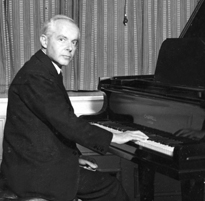Béla Bartók (1881-1945)
Born March 25, 1881 in Nagyszentmiklós (now Romania).
Died September 26, 1945 in New York City.

Hungarian Sketches (Magyar képek) Sz. 97.
Composed in August 1931 in Mondsee.
First performance (No. 4 not performed) January 24, 1932 with Massimo Freccia conducting the Budapest Concert Orchestra.
First complete performance: November 26, 1934 in Budapest with Heinrich Laber conducting the Philharmonic Society Orchestra.
Hungarian composer Béla Bartók was born in a small town which is now a part of Romania. A child prodigy, by the time he was four he could play dozens of piano pieces. After his father’s death his mother moved to Budapest. Bartók studied piano and composition at the Royal Academy of Music graduating in 1903. There he met Zoltán Kodály who became a lifelong friend. They shared an interest in authentic folk music. Bartók became known as a pianist and composer which led in 1907 to a teaching position at the Royal Academy. Among his students there were Fritz Reiner and Georg Solti.
In 1908 he traveled with Kodály across rural Transylvania, carrying unwieldy recording equipment to record the vanishing folk music of the region. The authentic Magyar music they discovered was quite different from the popular “Gypsy” music exemplified by Liszt’s Hungarian Rhapsodies. Magyar music had more in common with the music of the orient and Siberia. In his piano pieces, For Children (1908-1911), Bartók wrote accompaniment for over 80 Hungarian and Slovakian folk tunes.
In 1931 Bartók wrote orchestral transcriptions of earlier works such as the piano Sonatina of 1915 which became his Transylvanian Dances. He stated that he orchestrated these pieces for the money from concert performances and broadcasts. This also applies to the Hungarian Sketches. They are reworkings for orchestra of short piano pieces from several different collections that he wrote from 1909-1911.
There are five movements, using his favorite pattern of surrounding a central slow movement with two scherzos.
1. Este a székelyeknél (Evening in Transylvania)
2. Medvetánc (Bear Dance)
3. Melódia (Melody)
4. Kicsit ázottan (Slightly Tipsy)
5. Ürögi kanásztánc (Ürög Swineherd’s Dance)
The first piece Evening in Transylvania is No. 5 from the Ten Easy Pieces of 1908. A short rondo, it begins with a quiet clarinet solo over a gentle accompaniment, followed by a more animated theme played by the flute. The clarinet’s rondo theme reappears in the oboe. The flute’s animated theme then returns in the piccolo. The piece concludes with the woodwinds playing together over string chords. Bartók wrote that “…[it] is an original composition i.e. with themes of my own invention, but the themes are in the style of the Hungarian-Transylvanian folk tunes. There are two themes. The first one is a parlando-rubato rhythm and the second one … is more or less the imitation of peasant flute playing.”
The Bear Dance is the last piece (No. 10) in the same cycle. The gentle evening gives way to a boisterous dance. Over a bass ostinato from the tuba and timpani, we here a whole tone flavored melody resembling a kolomyjka folk dance in the woodwinds. Once again it is sort of a rondo where there is a theme with episodes interspersed. Bartók wrote that the piece was intended as an “Impression of a bear dancing to the song of his leader and growling to the accompaniment of a drum.”
Melody is the second piece from the Four Dirges op 9a (1910). It begins with a slow pentatonic melody played by the strings over a sustained background. The melody is then given to the clarinet and then the oboe. The texture increasingly thickens and increases in volume until we hear the melody in the low strings. The movement ends quietly with a few flute flourishes.
A Bit Tipsy is the second of the Three Burlesques op. 8c written in 1911. This humorous portrayal of a staggering drunk, his intoxication brilliantly depicted by an unsteadily rising and falling melody decorated by grace notes (hiccups), the occasional loud eructation from the tuba, and constant fluctuations in tempo. Judging from the number of times the piano version appeared on his recitals, this piece was a favorite of Bartók.
Ürög Swineherd’s Dance is from For Children (1908-09), vol. 2, No. 40.
The only piece to use actual folk song, we hear several whirling woodwind solos and a bagpipe impression in this brilliant finale.
Resources
[amazon template=iframe image&asin=B0007XHL02][amazon template=iframe image&asin=B000001GOT]
[amazon template=iframe image&asin=B007B2I68I]
This is an excellent resource and aided me in my listening of the piece. I always enjoy having some form of history or explanation to help me understand what I am hearing. I was also wondering if you also know where I could find/purchase the orchestral score for these works.